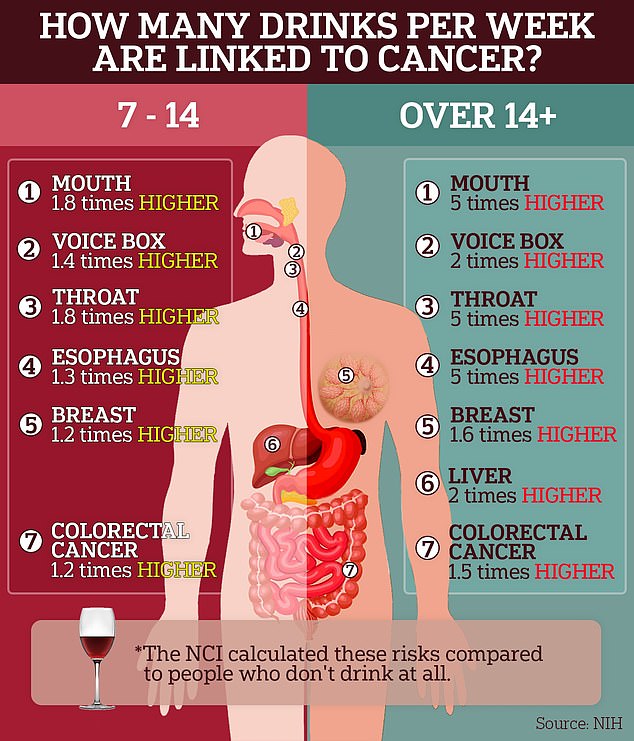When it comes to the links between alcohol and cancer, U.S. government experts say the jury is no longer out.
The leading U.S. voice on the disease, the National Cancer Institute, has linked alcohol to seven different types of the disease, including the deadliest forms.
The data suggest that, compared to someone who does not drink, the risk of developing cancer of the throat, mouth and esophagus is five times higher in women who drink eight or more glasses of wine per week.
For men, the risk is the same, but with a higher threshold: they must consume 15 or more drinks per week.
The National Cancer Institute’s fact sheet on cancer risk and alcohol consumption compiled decades of research investigating the link between cancer and alcohol. They found clear evidence of a link to seven types of cancer. One drink is equivalent to 12 ounces of beer, one shot of liquor, or five ounces of wine.
Alcohol affects each part of the body differently, and a person’s likelihood of developing alcohol-related cancer may also depend on inherited genes.
In the mouth and throat, alcohol can be irritating, damaging and inflaming the delicate cells that line the area, according to American Cancer SocietyThis may also make cells more susceptible to damage from other carcinogens, such as cigarette smoke.
Dr. Therese BeversMedical director of the MD Anderson Cancer Prevention Center, said: “The important thing to remember is that every time you drink, you increase your risk of getting cancer. Just like with cigarettes and processed meat, there is no safe amount of alcohol.”
However, the American public is largely unaware of this link. A 2017 study Research from the American Cancer Institute found that only 39 percent of Americans knew that alcohol was a risk factor for cancer.
At the same time, 218.7 million American adults report having drunk alcohol at some point in their lives. That’s about 84 percent of American citizens over the age of eighteen, according to the National Institute on Alcohol Abuse and Alcoholism.
As a result, about 75,000 Americans are diagnosed with alcohol-related cancers, which cause approximately 19,000 deaths. These include cancers of the liver, head, neck, esophagus, colorectal and breast.
Because drinking is so common, researchers at the National Cancer Institute have begun to track emerging trends linking alcohol to certain types of cancer.
For starters, the NCI has found that if you’re a woman who drinks seven drinks a week or a man who drinks 14 drinks a week, also known as moderate drinkerThe risk of developing mouth and throat cancer is 1.8 times higher than that of non-drinkers.
The report defines a drink as 12 ounces of beer, one shot of liquor or five ounces of wine.
For the same amount of alcohol, the risk of developing cancer in the pharynx, also known as the larynx, is 1.4 times higher than in people who do not drink.
Men who drink 15 or more drinks per week and women who drink eight or more drinks per week, also known as heavy drinkers, have a 2.6 times higher risk of developing laryngeal cancer and a five times higher risk of developing mouth and throat cancer.
Drinking a moderate amount of alcohol increases the risk of developing cancer of the esophagus (the tube that connects the throat to the stomach) 1.3 times more than not drinking at all.
Heavy drinking increases your risk of cancer five times more than not drinking at all.
Researchers have not found an increased risk of liver cancer in moderate drinkers, but in heavy drinkers, the risk of liver cancer is twice as high as in abstainers.
Doctors theorize that cancer in this part of the body is related to the way the body processes alcohol. As it breaks down in the body, it forms a chemical called acetaldehyde, which has the ability to damage DNA and proteins in the body, according to the National Cancer Institute.
This chemical can build up in the liver and other organs, mutating cells there and forming cancer.

For women, moderate drinking is defined as one drink or less per day, for a total of seven per week. Heavy drinking is defined as eight or more per week.

A standard drink is 12 ounces of beer, one shot of liquor, or five ounces of wine. Sometimes, the
In addition, moderate drinkers have a 1.2 times higher risk of colorectal cancer than non-drinkers. Heavy drinkers have a 1.5 times higher risk of colon and rectal cancer than non-drinkers.
Colorectal cancers may be linked to alcohol because drinking can prevent the body from processing vitamins and other nutrients that have been linked to cancer. For example, some studies They have shown that excessive drinking disrupts the processing of folate, a vitamin the body uses to keep cells healthy.
Outside the digestive tract, scientists have found that women who drink moderately have a 1.23 times higher risk of developing breast cancer than those who do not drink at all. Women who drink more than eight drinks per week have a 1.6 times higher risk of developing cancer.
Doctors say this could be because alcohol can increase the amount of estrogen circulating in the body. Estrogen is a hormone that the body produces naturally, but drinking too much of it has been linked to an increased risk of breast cancer.
People should be aware of these risks, but those who limit their alcohol consumption need not worry about their nightcap, said Professor Sir David Spiegelhalter, a statistician at the University of Cambridge.
“Frankly, I get irritated when the harms of low levels are exaggerated, particularly with claims such as ‘no level of alcohol is safe’,” said Sir Spiegelhalter.
“I don’t think the evidence supports that to begin with, but there’s no safe level of driving, there’s no safe level of living, but no one’s recommending abstention.”


